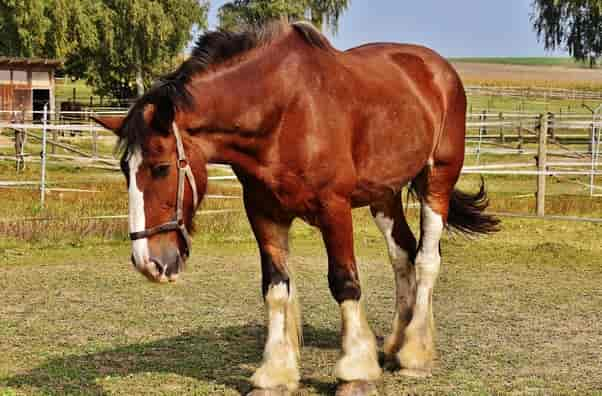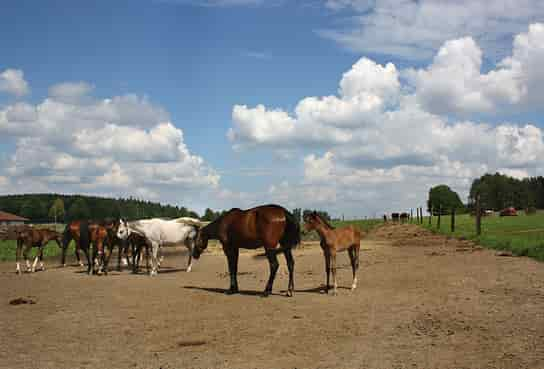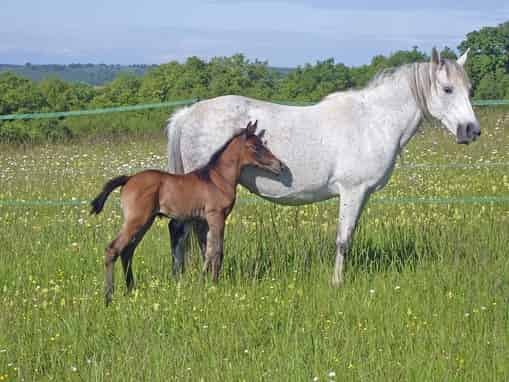Horse farming
I am discussing the basic ideas of horse farming and how to care of
 |
| Horse farming |
Horses are herbivorous and exhibit hindgut fermentation. So for a successful horse farming, it is essential to exercise proper feeding
management in horses to obstruct both overfeeding and underfeeding. The
salient features are highlighted
1. Do not provide nonnitrogenous protein substances like
urea to horses of all categories as they can not digest like ruminants.
2. Horses should be provided
3. Body weight (kg)
Body weight (kg)
Bodyweight (kg )
5. As far as green forage is concerned
7. Regularity in feeding, avoid full feeding before and
after exercise and changing, ration composition gradually are most important
symbols in horse feeding.
8 In horses, fodder roughage is given be mixed
9. No group feeding is advised is
concerned
10. To avoid mineral deficiency, daily 25-40 gm mineral the mixture is added
11. A horse (without work) weighing 400 kg body weight will
require probably 0.38 kg Digestible crude protein (DCP), 20 gm calcium, 20 gm
phosphorous and 70mg carotene.
13. And for heavy work, it requires 1.10 kg DCP, 60 gm
calcium, 60 gm phosphorus, and 170 mg
14. Horses should not be watered
16. For general practice, it is to provide water before
feeding.
18. Horses are seasonally polyestrous. Early spring is
considered India .
19. puberty is attained
20. Mating should be allowed weight,
Basic horse care
For basic horse care essential Oils and how it applies to use with horses; We
will explore some of their histories, how you may have been misled
Essential Oils themselves have been around for hundreds of
years and in today's world more and more people are turning to their use for
use on themselves and their animals and specifically the horse.
Using these various oils within the equine industry has
a somewhat limited historic time frame since it has only been started be
accepted have
Getting back to the background of Essential Oils; Each oil
contains hundreds of compounds that have been found it is introduced nose
Best horse supplements
So now that we have somewhat covered the way that As the best horse supplements e ssential Oils are compiled as well as back what can
be done it, Essential Oils are known
We continually stress that when working with horses and
introducing them to the use of Essential Oils, it always needs to be done due to the fact that be digested to safely use is applied be diluted blend that that The Proprietary Essential Oil Blends that we use are diluted
Another important point to bring out is that there are no
proteins in any essential oil, so there can be no allergic reaction to any of
these oils. It is the proteins in various items that create an allergic
reaction to that specific item.
In case you might be wondering it is accomplished very small is called more or
less is involved is referred this the area of in nature as well as
Horse essential oil
The Amygdala is part of the "limbic system" of the
brain that does consist tend
to be be affected is directly affected
Let's look at one simple product that has been marketed been used are proven
I have seen a true acceptance of the use of Essential Oils
by the horses, if not by the owners most times. I have found that horses
don't lie; it opposition can be
overcome
Horse feed
When I was advised
The word Metallic is enough to turn me off feeding these
minerals to my horse. I wanted something more natural. I came across a brand of
horse minerals that are plant-based and all-natural. With 74 plus plant
ingredients to keep a horse healthy and happy, below are just are
Premium Horse Mineral Ingredients.
Sea Plants
Kelp
Age-Old Healing Plants and Herbs
Colloidal Minerals
Biotin
Moringa Powder
MSM Plant Sulphur
Clay Dolomite
Clay Calcium Bentonite
Diatomite
Natural plant minerals are better for a horse
Humans rarely go well on high starch or high sugar,
which leads to diseases like diabetes. Diabetes can raise the risk of a heart attack or stroke by 50%. If we can improve a horse diet with healthy feed and
natural supplements, it has to be better than feeding them unhealthy feed
filled with sugar and starch.
If humans can get a disease like diabetes, it is crazy to
think a horse would be immune to this. Horses shouldn't have too much
sugar; it
Minerals play an important part in a horse's overall health,
and natural minerals are a better choice to help a horse is caused
To stop this from happening, a well-balanced diet is
essential... listen to your horse. My horse told me I need to find out about Australia 's
best-kept secret, Paradise Nutrients.
Horse worms
One of the many health issues or problems your horse may
acquire
But how does a horse get these worms? Since your horse loves
to spend time in the pastures, your pet munches on the grass present
outside. Your horse, though, may not be munching on clean grass or even on grass
alone. There are parasitic larvae present in the pasture. And since your horse
also eats clover and other grains present on the ground, your pet may also
swallow some undesirable bugs, bots, and worms.
If these harmful worms are not treated
To prevent worms from proliferating in your horse's internal
systems and to control and get rid of them, you need to regularly deworm horse owner
For the deworming process to work, your horse needs to
swallow or ingest the correct amount of prescribed deworming paste. You may, however, encounter problems or difficulties in carrying out the deworming
process. Below are some tips you can follow to make the deworming process
easier for you and your pet horse:
• Make sure you give your horse the correct deworming medication. This needs to be the right one that your vet prescribed
for your pet.
• Don't make a big fuss about the deworming process. You
want your horse to stay relaxed and calm during the whole process.
• Use the a
• For your horse to swallow all the paste you give him or
her, mix the medicine with some delicious treats or food. You can mix the paste
in the apple juice your horse will drink or with a wet carrot or apple mash
that your pet will have for breakfast.
• You can use some calming remedies or techniques if your
horse remains overly anxious.
• If your horse is still not being cooperative at all or keeps
spitting out the deworming paste, you can consider bringing your pet to an
expert veterinarian. The vet will have all the experience and
expertise in handling this important task.
Horse care
The most important things you will need as a horse owner are
money and time. Horses are expensive to own and care for, and you also need time
to care for them properly. How much it costs to own a horse varies
according to where you live, how your horse is kept
• Livery, stabling, and grazing
• Feed, hay, and supplements
• Vaccinations, worming treatments and routine veterinary
checks and treatments and veterinary care for unforeseen medical
requirements
• Shoeing and hoof care
• Insurance
• Tack
• Stableyard
• Any horse rugs that may be required
• Bedding
• Riding clothes and equipment
Also, don't forget the cost of getting to and from where you're the horse is kept
In terms of time, how much you need will vary according to
how much of the day to care you intend to do yourself. If you go for part or
full livery, some or all of this can be done
2. Essential Horse Equipment
Tack
• Saddle with leathers and stirrups
• Girth
• Saddle Pad
• Headcollar
• Bridle, reins and bit
• Rugs/blankets/sheets
Grooming kit basics:
• Hoof pick
• Body brush
• Mane and tail brush
Stable equipment
• Feed and water buckets
• Hay Rack/Net
• Bedding
• Stable mats
• Stall guard
• Salt block and holder
3. Basic Horse Riding Clothing
Riding Hat - The most important piece of clothing, essential
for safety.
Boots - With a heel and sturdy toe, these can be a long riding
boots, jodhpur
boots or paddock boots - you might find you need over one type.
Jodhpurs - Essential for a comfortable ride.
4. First Aid Kit
For you and your horse, the basics:
• Gauze Pads
• Self-Adhesive Bandage
• Scissors and tweezers
• Antibiotic Cream
• Iodine
• Rubber Gloves
You might also want to consider fly repellents and
treatments, hoof treatments and wound powder for minor cuts and scrapes.
5. Advice
Owning a horse for the first time is a massive undertaking.
It's helpful to have people around who are experienced
Basic horse care for beginners
Most of the people owning a horse are of the opinion that
equine supplements are a quick fix remedy for providing an immediate result on
the health of their pony. An effective diet that is created be provided type of sure that the interior damage caused mainly to the muscular tissues of the
animal can be restored is continued
To ensure that the inadequacies are eliminated the
horse should be fed The remaining should be derived
When feeding the pony with dietary supplements, it is again,
especially helpful in identifying the products that are placed An optimum level of fiber is
included
Besides different supplements like equine
supplements, there are some online stores dealing with different farm
products and even grooming supplies. In addition, they have different products like whips, treats, stable products, shampoo and
conditioners, horse wear products, and first aid products for the animals.
Horse breeding information
The most natural method of breeding horses is when the
stallion runs loose with the mares; However, nowadays there are three other main
methods used:
Artificial insemination where semen is collected
In-hand breeding, where a stallion and mare are brought
Embryo transfer when an embryo is taken
Allowing a stallion to run with his mares is the most
traditional method, and the horses can behave as they would in their
natural wild state. However, it is not a method that is widely practiced due to been mated high and such injuries can be difficult to spot or
to treat as the stallions rarely welcome human contact in their herd.
Breeding is the most commonly used method in
commercial studs. The mare and the stallion are brought Mares are frequently placed due dates are known
Artificial insemination has become a lot more common as it
is making breeding with top stallions accessible to all. It also reduces the
management of the mares as they can be inseminated does require Many
stallions can be taught be shipped
Embryo transfer is the most modern of the methods and has
been developed is taken is used
Horse supplements
If you are an aspiring horse rider and if you have been
reading a lot of horse riding magazines lately or even if you have been riding
horses for decades, you have probably noticed that there are dozens if not
hundreds of different horse supplements that you can buy today.
From joint supplements and callers to digestive aids and
garlic supplements... There are dozens of different products to choose from, and
each one of these products has a lot of different formulations.
In today's article, I would like to talk with you about
different feed balancer formulations. This information should help you choose the right feed balancer for your horse, but before we'll get into
specifics, I, first, want to talk with you about why should you supplement
your horse's diet with a feed balancer.
The fact is that quite a lot of horses all over the world
suffer from nutrient deficiency and their organisms don't get as many
vitamins, minerals, and nutrients as they need. Because of this nutrient
deficiency, quite a lot of horses do not look and feel as good as they could, and this is where feed balancers come into play. Feed balancers are just
like multi-vitamin supplements for humans; they are packed
Now, once we know about why supplement your
horse's diet with an equine feed balancer, let's talk about different balancer formulations. For these supplements, there are four main
types of balancer formulations:
Performance
Veteran
Everyday use
Low calorie
Each of these formulations has different nutrient
ratios. For example, performance feed balancers are are known The end result is improved
Veteran balancers, on the other hand, Glucosamine is needed
I hope this information will help all of us for successful horse farming and breeding.
For more exotic petsupdate please click here.
https://www.exoticpetslovers.xyz/2019/06/popular-horse-breeds-arabian-horse-riding-gypsy.html
https://www.exoticpetslovers.xyz/2019/06/popular-goat-breeds-goat-care-boer-goat.html
For more exotic pets
https://www.exoticpetslovers.xyz/2019/06/popular-horse-breeds-arabian-horse-riding-gypsy.html
https://www.exoticpetslovers.xyz/2019/06/popular-goat-breeds-goat-care-boer-goat.html








0 comments:
New comments are not allowed.